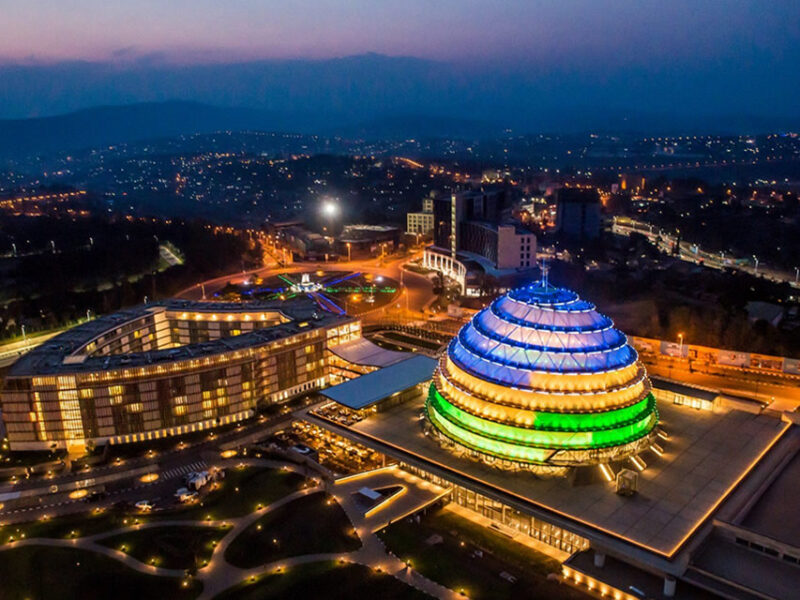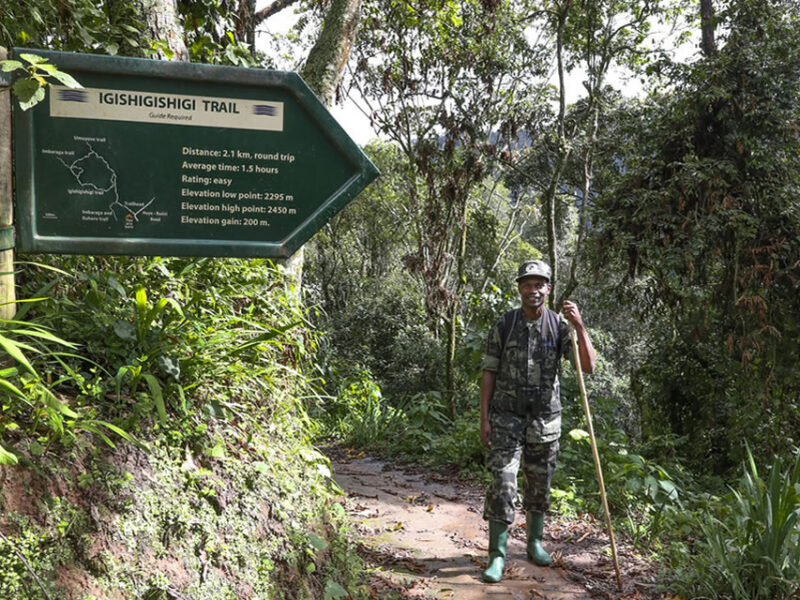
Kigali City – Business District
Kigali City is the Capital City of Rwanda, situated almost in the Centre of the country. Its geographical position is Latitude 1°57’S and on longitude 30°04’E. Kigali is located in a natural region called Bwanacyambwe within the proximity of the Nyabarongo river basin, between Mt.Kigali(1852m high) and Mt.Jali.The city is built on interlocking hills, which progressively converge and are separated from each other by large valleys giving them oval shapes. Originally the city occupied the hills of Nyarugenge and Nyamirambo which covered an area of about 200hactares at the time of independence but has since expanded to cover Kiyovu, Gikondo, Kicukiro, Kacyiru, Kimihurura, Remera Kicukiro, Nyarutarama, etc. While on your visit to Kigali for a conference or business trip you need a few our to get the real feel and taste of Rwanda the Land of a thousand places, These are the suggested places that you can go to visit and unwind.
Richard Kandt’s House/Museum of Natural History
Dr.Richard Kandt was a medical doctor by profession; he was also a soldier, an explorer, a scholar, a poet, and an avid naturalist. He was born of a Jewish Kantorowicz family of Posen in 1867. After attaining a degree in medicine in 1894, completing his military service and a stint as a physician assistant, he embarked on an exploration of Africa. His inspiration was to solve the puzzle of the source of the Nile thus Rwanda became his destination naturally. With an inherited personal fortune of 80,000Marks, he arrived at the East African Coast in 1897 and organized an expedition of 150 members.
In June 1898 he stayed at the court of the King of Rwanda from where he finally discovered the source of the Nile in Rwanda in August 1898. Later he settled at Shangi on the shores of Lake Kivu from where he thoroughly discovered Rwanda.
In 1902, he returned to Germany. In 1904, he published his book “Caput Nile-a a sensitive Journey to the Source of the River Nile”. It was reprinted in 1991.
In 1905 he returned to Rwanda to continue with his research. By 1906 he had identified a site in Gakinjiro on Nyarugenge hill as his residence. A year later, it doubled as his headquarters when he was appointed the first colonial Resident Governor of Rwanda in 1907 a position he held up to May 1916 when the Belgium troops occupied Kigali bringing an end to the 22 years of Germany colonial rule.
In 1908, he named his headquarters Kigali; after the nearby Mt.Kigali.It was officially gazetted on 19th October 1908. Richard’s task as Governor was to develop Rwanda into a modern state. In this regard, he identified and introduced coffee as a cash crop and identified and identified the Irish Potatoes as food crops to meet the subsistence needs of the local population. He also embarked on the development of infrastructures. It should be remembered that during his tenure the colonial office had approved a railway line for Rwanda. The line has not been constructed yet.
In 1914, Richard Kandt left Rwanda never to return. While on a vacation in Germany, the First World War broke out and he volunteered his services as a surgeon to the Bavarian Army. In 1918, he died in Nuremberg as a consequence of gas poisoning at the frontline. His grave is in Johannisfriedhof Graveyard in Nuremberg(grave N°478)
Places of Worship
European missionaries, notably the White Fathers, introduced Christianity to Rwanda in the late 19th century. A 2001 study indicates that about 94% of the population is Christians: 50% Catholic and 44% Protestant. Muslims account for about 5% of the total population and about 2% professed no religion at all.
The Roman Catholic Archdiocese of Kigali (Latin: Archidioecesis Kigaliensis) is an ecclesiastical territory of the Roman Catholic Church in Rwanda. It was erected from the Archidiocese of kayi by Pope Paul the IV on April 10 1976 with the dioceses of Butare, Byumba, Cyangugu, Gikongoro, Kibungo, Nyundo, Ruhengeri.
The mother church of the archdiocese and thus seat of His eminence the Archbishop is St. Michael’s Cathedral the oldest in the Country.
Nyamirambo Muslim Quarters
Islam was first introduced into Rwanda by Muslim traders from the East Coast of Africa in the 18th century. Since its introduction, Muslims have been a minority in the territory
The word Nyamirambo is derived from the Kinyarwanda word,’ Imirambo’ to mean dead bodies. This is the point where the Banyoro and Banyarwanda had a fierce battle during the post-colonial era. The Banyoro had intentions of capturing and expanding their territory to Rwanda.
Camp Kigali (Venue of the massacre of Belgian Blue Beret at the onset of Genocide). The 10 Belgian in MINUAR under the command of General Romeo Dallaire were deployed to guard the Arusha Accord transitional Prime Minister Uwilingimana Agatha.At the onset of Genocide, the Ex. Far soldiers invaded the home of Uwilingiyimana Agatha and disarmed the Belgian soldiers (10) and transported them to Camp Kigali and Killed them from there.
KIST
This was a former Military Training School at this site. There is a small house just next to the administrative block which in the late 50s was ‘Ecole des Officiers’ where the Habyalimana was. In it was expanded through the Belegian Military Cooperation and became ‘Ecole Superior’militarie. This has been transformed into the leading National University for science and technology to strengthen the education status in the country and help Rwanda cope with fast-developing technology in the world.
Kigali Independent University – This is the first privately run University in Rwanda that has Changed the trend of Higher education in Rwanda. The setup of the campus and resources available to the people of Rwanda and foreigners is amazing.
The Parliament – Shell marks are still visible on the walls of the Parliament Building because of the power struggle during the 1994 genocide era.
The Legislative Power is exercised by a bicameral Parliament which consists of the Chamber of Deputies (members are called Deputies) and the Senate (members are called Senators). After the October 2003 parliamentary elections, women achieved 48.8% representation, the largest in the world.
The Parliament of Rwanda was established by the Constitution of June 4th, 2003. It is the first democratic Parliament since national independence in 1962 that includes seven political parties (the RPF, PDC, PDI, PL, PSD, PSR, and UDPR). The previous transitional parliament (1994-2003) set up immediately after the 1994 genocide. It was governed by the then fundamental law mainly based on the 1993 Arusha Peace Agreement.
National Bank of Rwanda – (Banque Nationale du Rwanda) is the central bank of Rwanda. The bank was founded in 1964 and is quartered in Kigali. The National Bank of Rwanda has undergone a transformation since 1911. Rwanda, which was kept apart from the Leopoldville center of influence, noticed once again that the installation of various common institutions in Bujumbura would harm its economic development. The four years of the economic and monetary union were just a failure, each party feeling cheated and blaming each deficiency on the other party. The divorce between Rwanda and Burundi became a reality when the economic union was liquidated from 1st January 1964.
The National Bank of Rwanda, established by the Law of 24th April 1964, came into force from 19th May 1964 with the aim of fulfilling one of its main missions, namely the issuing of currency on the Rwandan territory. The B.E.R.B. rights and obligations were ex officio transmitted to the Royal Bank of Burundi (B.R.B.) and to the National Bank of Rwanda (B.N.R.).
Rwanda National Television and Radio (ORINFOR)
ORINFOR was established in 1973 to operate the electronic mass media national radio and Television. Today almost 500 employees work through the coordination of ORINFOR to secure access to a broad and diverse spectrum of information relevant to all religious and other groups making up today’s society of Rwanda.
ORINFOR serves as an umbrella for the three main national news- and media organizations including TV- and Radio Rwanda
Seat of the Radio Television Libre de Milles Collines (RTLM)
The antennae of the infamous hate Radio which was instrumental in mobilizing Hutus to Kill the Tutsi. The Radio was sponsored among others the fugitive businessman Cyprien Kabuga. It would seem that the genocide had been planned long in advance and that the only thing needed was the spark that would set it off. For months, Radio-Télévision Libre des Mille Collines (RTMC) had been spreading violent and racist propaganda on a daily basis fomenting hatred and urging its listeners to exterminate the Tutsis, whom it referred to as Inyenzi or “cockroaches”
Sports and Recreation
Swimming – Nyarutarama Tennis club, Novotel, La Palace hotel, Kigali Serena hotel, Mille colline Hotel. Cicle sportif.
Golf – Kigali Golf club.
Tennis – Nyarutarama Tennis club, Cicle Sportiff.
Night Clubs – B Club, Planet
Basket Ball – Nyamirambo Court.
Foot Ball – Amahoro Stadium, Nyamirambo Stadium
Art & Galleries
Ivuka Arts, the Kinyarwandan word for birth, also evokes the companion idea of rebirth. And indeed, Rwandan contemporary art demands nothing less at this critical moment in history.
A little over a decade ago, during the terrible days that befell the Land of A Thousand Hills, the world witnessed the passing of what may have been today’s Rwandan Masters. Rwanda’s only major art school, L’Ecole d’Art du Rwanda, was destroyed, along with countless works of art that defined the country’s contemporary cultural heritage.
But though the body was destroyed, the soul refused to die.
This new gallery is located in Kakyiru. www.ivukaarts.com


